Today, we’re announcing the next wave of AI innovations from Microsoft Education that will help unlock productivity and personalize learning. This includes expanded Copilot for Microsoft 365 availability and Loop coming to education. We’re also sharing news about AI built for education such as Reading Coach and features designed to free up time for educators and personalize learning. As part of our continued work to build AI literacy, we’ve launched our latest course for educators and a new learning path on Microsoft Learn. And earlier this week we outlined Microsoft’s position and themes for policymakers to consider around advancing youth online safety and wellness.
Bringing the future of productivity to education
Last month, we were thrilled to announce several Microsoft Copilot expansions for education audiences. Copilot with commercial data protection will be available to all faculty and higher education students who are 18+, including users of our free offers. And on January 1, 2024, education faculty and staff became eligible to purchase Copilot for Microsoft 365. We’re already seeing innovative organizations like The University of Hong Kong, The University of Manchester, and GEMS Education lead the way as early adopters. We shared additional updates this week including eligibility for Office 365 A3 and A5 faculty customers and removed the 300-seat purchase minimum to empower organizations of all sizes.
Microsoft Loop is a flexible, AI-powered collaboration app that can help you think, plan, and create together. We’re excited to share that Loop will be included in Microsoft 365 A3 and A5 plans, including Student Use Benefit in early March 2024. Customers with Office 365 A1 can continue creating workspaces and pages through June 30, 2024, and will be able to access them afterwards. Watch the video Microsoft Loop – think, plan and create together like never before to learn more about Microsoft Loop and try Loop today!
Transforming reading experiences
It’s well known that reading is foundational to a student’s academic success; studies show that fluent readers are four times more likely to graduate high school and get better jobs. Educators and parents alike are looking for ways to help students improve reading fluency in a way that keeps them engaged and prior research has found that personalized learning is one of the most effective ways to help close learning gaps. With the latest AI technology, we have an opportunity to provide learners with personalized, engaging, and transformative reading experiences. Reading Coach, a Learning Accelerator now powered by generative AI, does just that. You can sign up for a preview of Reading Coach today and try it for yourself at Reading Coach Web app preview.
Reading Coach was already providing learners with personalized reading practice, instant feedback about pronunciation and fluency, while also giving insights back to educators. Today we’re sharing new features that will fuel student agency and motivation with dynamically created stories that adapt to their reading level and individual challenges.
Reading Coach takes a unique approach to implementing generative AI with guardrails. Learners select the story’s protagonist, setting, and are provided with choices that alter the plot of the story as they read. Reading Coach combines these inputs with the learner’s selected reading level, and over time, words they mispronounce to dynamically create personalized stories that keep students engaged and in the driver seat. Students stay engaged with the power to pick a path of a story while they progress through the chapters. The story content is moderated for quality, safety, and age appropriateness. And in addition to creating AI-powered stories, learners can also pick leveled passages from the curated ReadWorks library.
Reading Coach intrinsically motivates learners to continue advancing their skills in several ways. They can unlock new story settings and characters, earn badges that reward their efforts, and see their pronunciation and fluency improvements in progress reports.
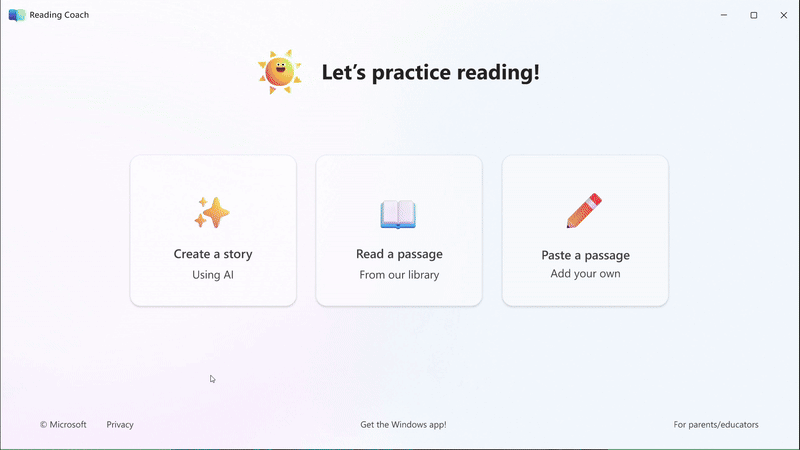
We’re making Reading Coach more broadly available than ever, so that learners can read on the device of their choice, at home or school. It will be available on the web and as a Windows App, at no cost to anyone with a Microsoft account. Additionally, we’re making it easier for teachers to create Reading Coach practice assignments by adding integration with popular Learning Management Systems (LMS) such as Canvas, which will be available in late Spring 2024. Learn more about how Reading Coach works on our support documentation pages.
These new Reading Coach features build on top of the passage generation and comprehension question generation in Reading Progress which will be available for preview late January 2024. With the use of AI in an impactful, safe, responsible way, we believe that personalized learning at scale is within reach.
Saving time and differentiating instruction
In addition to reading, over the past year we have been focusing on opportunities to free up time for educators by further enhancing our products with AI. Today, we’re sharing more features coming to Microsoft Teams for Education and Microsoft Reflect to help tailor content. They will be generally available at no additional cost to all education customers later this year.
All these tools quickly and easily generate content such as reading passages, comprehension questions, rubrics, assignment instructions, and more. Educators are always kept in control as the experts and can review initial drafts of content, generate more options, make edits, or choose to discard. Educators can personalize learning with the click of a button by using filters like age, language, topics, and increasing or decreasing the complexity of the content. And education organizations can choose to turn these features on or off.
Classwork is a feature in Teams which is built to manage your curriculum and allows educators to create and organize class resources including Assignments, Files, Links, Channels, Class Notebook pages, and more. Classwork module generation helps easily kickstart content with module suggestions based on your subject, student age range, and scope of learning.
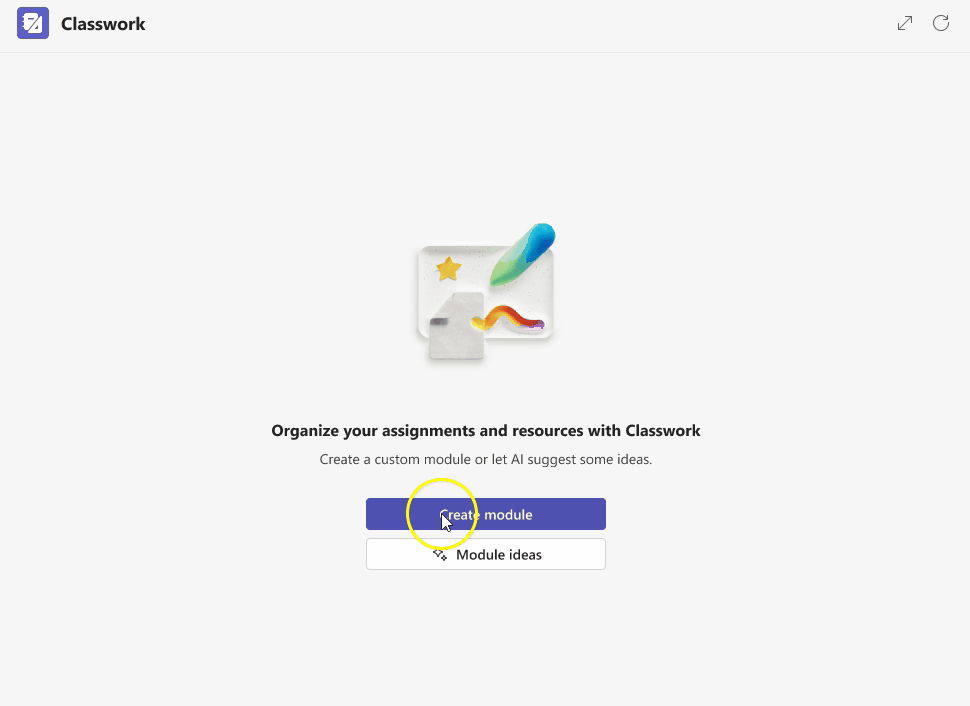
When creating an Assignment in Teams, educators will be prompted with opportunities to leverage AI to easily emphasize key content, simplify, or add more detail, learning objectives, and even emojis. In each case, educators are reminded that AI-generated content may be incorrect, and they’ll need to choose to keep, discard, or regenerate the content.
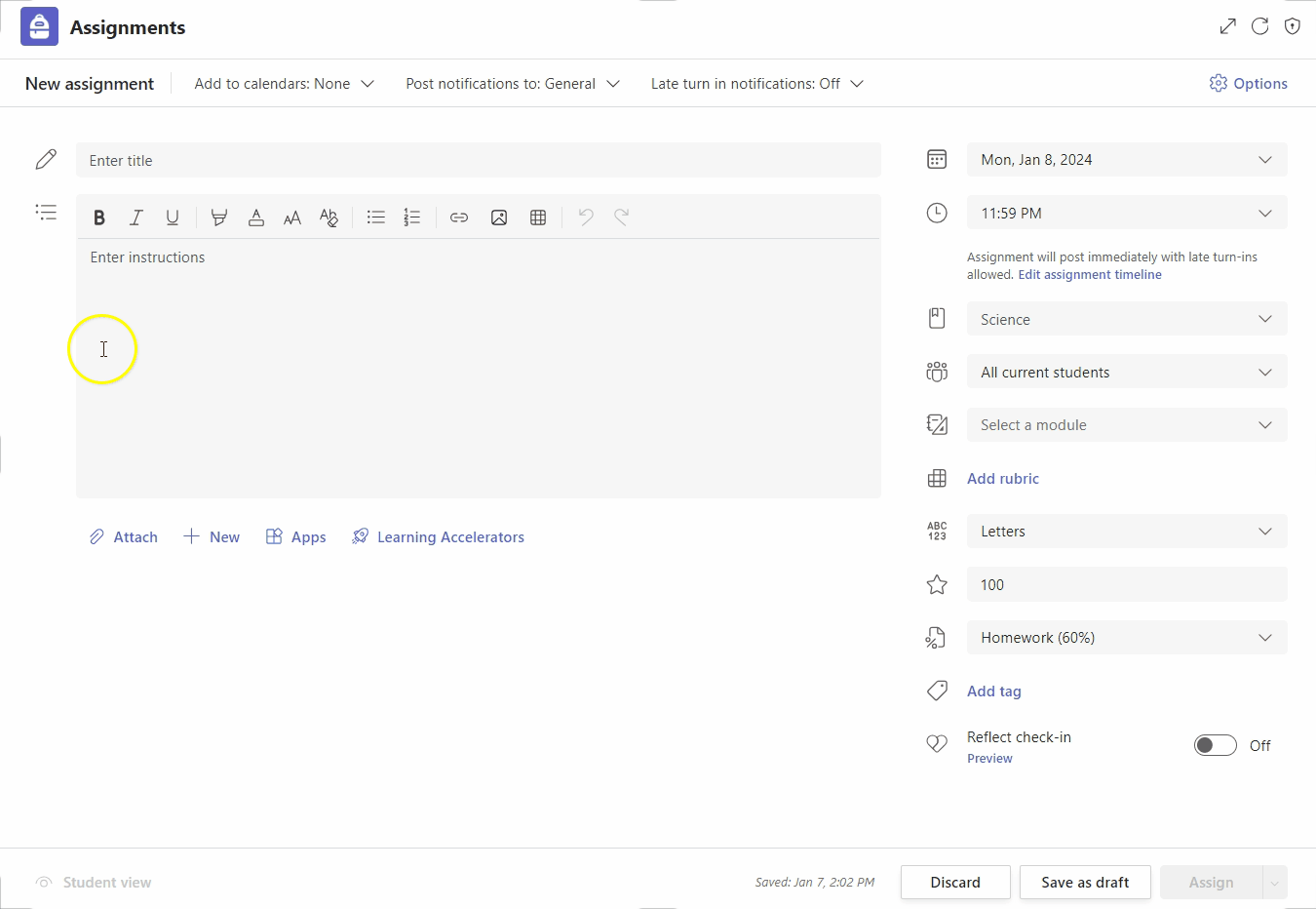
Once the Assignment is ready, educators can generate a rubric draft after providing title, evaluation, age range, scale, and criteria detail. Educators are then encouraged to review thoroughly and make any edits before attaching to an Assignment.
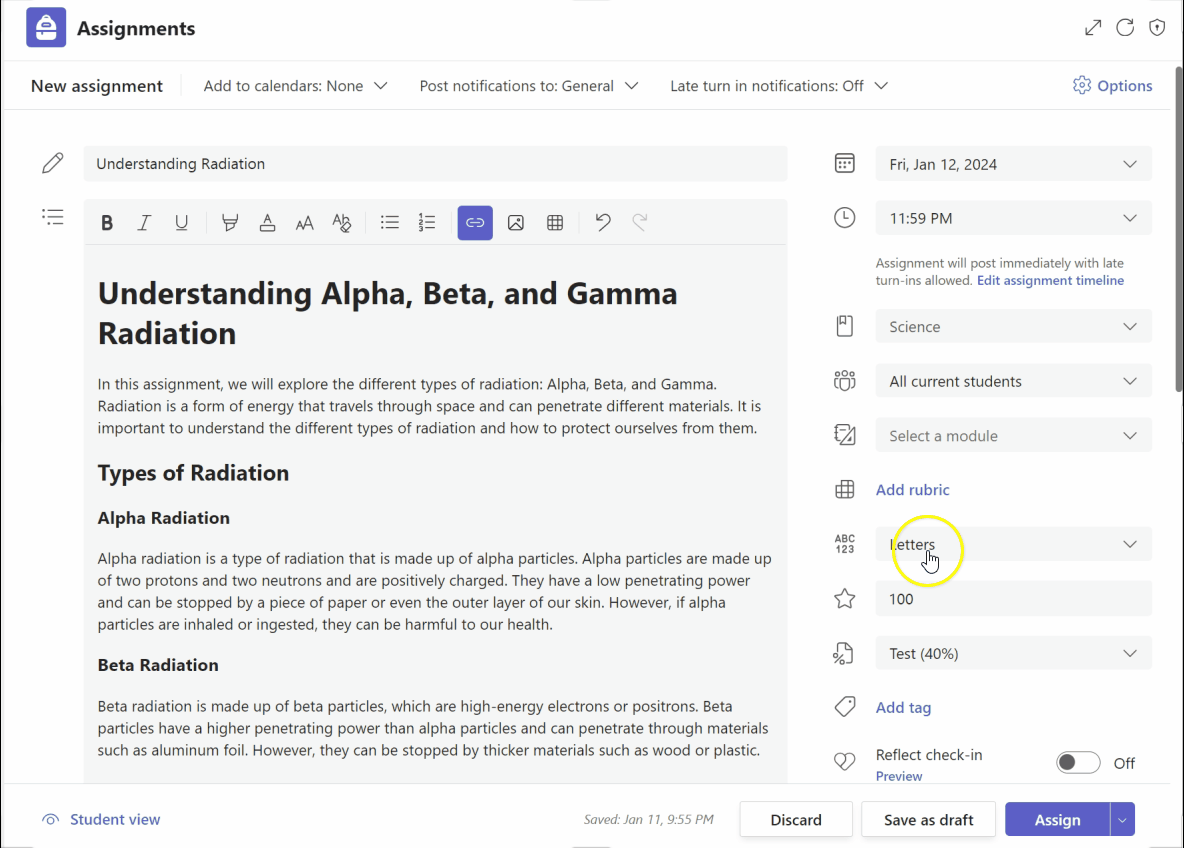
Microsoft Reflect is a tool that helps students identify and express how they feel in safe and fun ways, building their emotional vocabulary and giving educators the insights they need to provide active support. Reflect can now further enhance understanding by enabling educators to generate options for learners to specify reasons behind the emotion. These options are tailored to the check-in question set by the educator and draw on multi-year research by experts from the Stanford Graduate School of Education. Educators can regenerate, manually add, or completely discard results. Reasons can then be grouped at a class level into a predefined list of focus areas with strategies on how to navigate each one in partnership with Challenge Success, a nonprofit affiliated with Stanford’s Graduate School of Education.
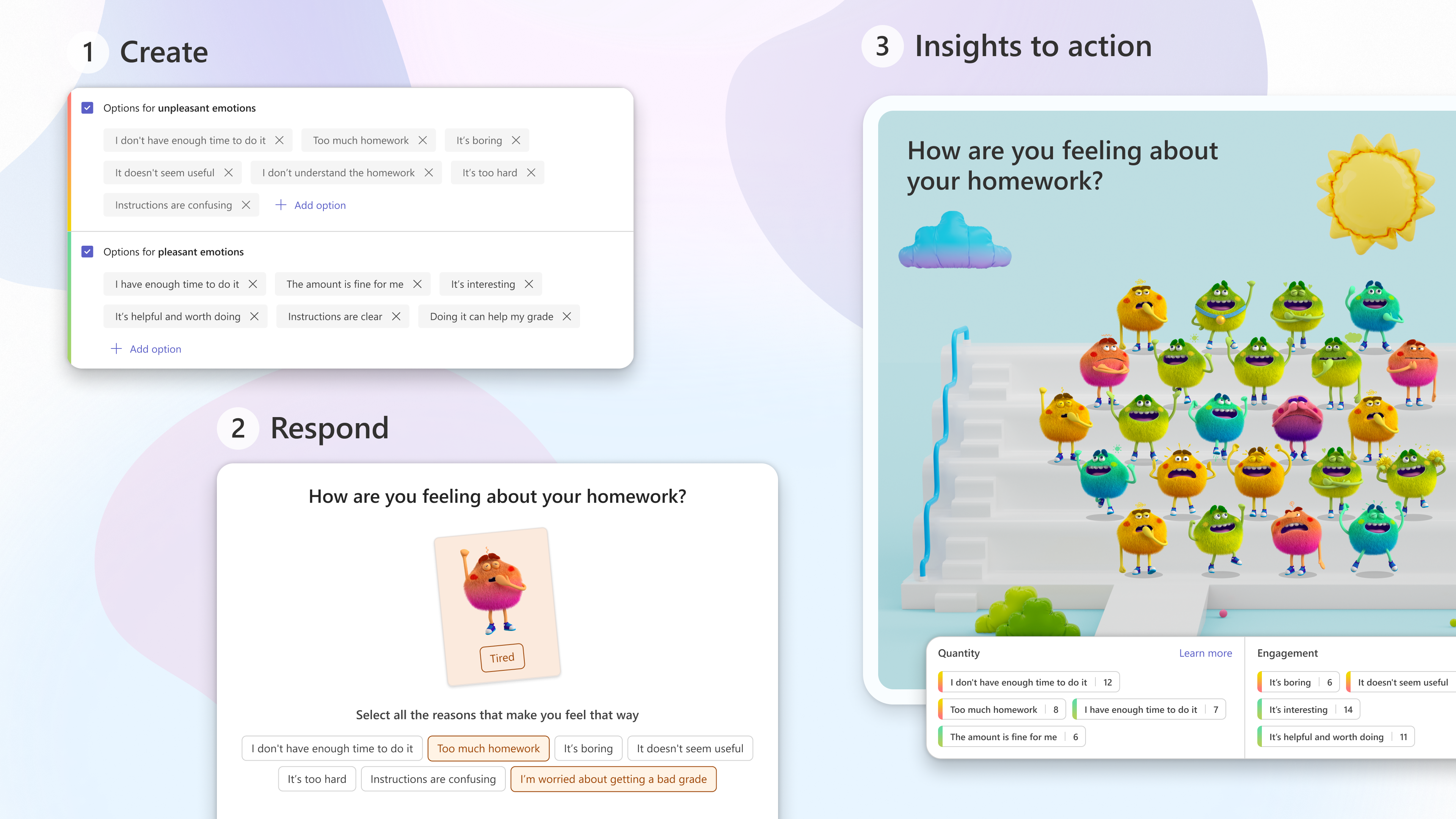
Building AI literacy for educators and students
As more exciting features are developed, we’ll continue to support building AI literacy in parallel. We’re now launching the AI for Educators Learning Path on Microsoft Learn, made up of three modules to help educators learn about and benefit from AI. It begins with empowering educators to explore the potential of AI, continues into how to enhance teaching and learning with Copilot, and finishes with our newest addition: Equip and support learners with AI tools from Microsoft. This new course walks educators through how to help learners discover, interact, and create with AI and generative AI.
Educators can then leverage the AI Classroom Toolkit to help teach and support students in using generative AI safely. It’s a creative resource that blends narrative stories with instructional information to create immersive and effective learning experiences for educators and their students.
Advancing youth online safety and wellness
As we head into 2024, there is an urgent call to action for us all to take steps to protect youth safety and privacy online and to ensure that technology—including emerging technologies such as AI—serves as a positive force for the next generation. As policymakers and regulators weigh potential measures to help advance safety outcomes in the coming weeks and months, it is essential that they consider both the benefits and the risks of technology for young people. Read more in our blog about Microsoft’s position on these issues and themes for policymakers to consider as they work through initiatives to protect youth safety and privacy online.
Learn more about today’s announcements in our latest What’s New in Microsoft EDU blog and join us at Bett next week to explore AI in education with Microsoft.










